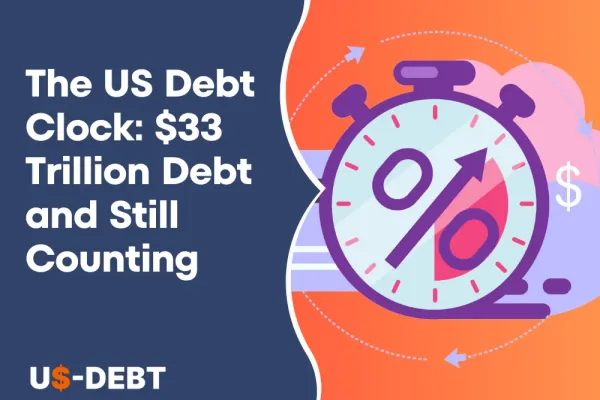Amidst the vast digital tapestry of economic data, the US Debt Clock stands as a colossal enigma, beckoning both intrigue and trepidation from the populace. But, to what extent may we truly certify the integrity of this fiscal chronicle? Does it faithfully mirror the economic pulse of the nation, or does it conceal subtleties beyond our immediate perception? We will embark on a comprehensive odyssey to scrutinize the precision and ramifications of the data enshrined within the US Debt Clock.
Introduction to the US Debt Clock
-
Definition and Purpose of the US Debt Clock
The US Debt Clock stands as a real-time manifestation of the United States' national financial burden. Nestled within the heart of Manhattan, New York City, this clock undergoes daily updates during business hours. This intricate device unveils not only the comprehensive sum owed by the United States government but also the indebtedness per individual and the burden borne by each taxpayer.
The conception of the US Debt Clock was borne from a desire to heighten cognizance regarding the escalating national indebtedness and to impel American citizens to hold their elected representatives accountable for their financial prudence. This clock serves as a potent visual mnemonic of the fiscal load that the national debt imposes upon the populace.
-
Understanding the Figures Displayed on the US Debt Clock
Understanding what these figures signify is key to grasping the nation's economic situation. From the national debt and unfunded liabilities to government spending and tax revenue, each element on the clock paints a different facet of the financial landscape. The US Debt Clock displays the following figures:
- Total Debt: The total amount of money owed by the US government.
- Debt Per Person: The average amount of debt owed by each American citizen.
- Debt Per Taxpayer: The average amount of debt owed by each American taxpayer.
Two-thirds of the clock shows the public debt by way of treasury bills, notes, and bonds - this covers individuals, businesses, and foreign governments. The other third of the debt is what the government owes to itself - this covers federal programs like Social Security.
History and Evolution of the US Debt Clock
A running total display the size of a billboard that illustrates both the gross national debt of the United States and the debt owed by each American family is called the US Debt Clock. Real estate developer Seymour Durst of New York placed it on the western side of One Bryant Park, west of Sixth Avenue between 42nd and 43rd Streets in Manhattan, New York City, to draw attention to the nation's mounting debt.
-
Why US Debt Clock was Unplugged in 2000?
On February 20, 1989, the US Debt Clock was placed, with a total debt value of USD 2.7 trillion. The 305 lightbulbs on the display cost $500 a month to maintain, while the clock itself cost $100,000 to create. Thanks to an updating system, the display was kept up to date every week with the latest data published by the US Treasury, with the predicted rate of debt increase being set.
Following his father's passing, Douglas Durst assumed the presidency of the Durst Organization, which is the owner and operator of the clock. After six years in operation, the clock stopped counting on November 15, 1995. A federal government shutdown caused the clock to be stuck at $4,985,567,071,200. The clock malfunctioned in 1998, not long after the figures topped $5.5 trillion. The reason given was that the numbers "were too high." Artkraft responded by upgrading the computer inside the clock.
The clock began to tick backward in early 2000, as the national debt was starting to decline. It displayed a $5.7 trillion national debt with a portion of about $74,000 for each family. Given that the clock's original intent was to draw attention to the growing national debt, the figures' inversion sent a contradictory message and further evidence that the display was not intended to function backward. The clock was supposed to be disconnected on September 7, 2000, it was revealed in May 2000.
Douglas clarified that the clock's purpose was to highlight the nation's mounting debt, which is why it was chosen to be disconnected. With the national debt reaching approximately $5.7 trillion, the clock was disconnected and covered in a red, white, and blue curtain in September. But in July 2002, less than two years later, the curtain came up and the clock began to tick upward, this time recording debt that began at $6.1 trillion.
-
Evolution of the US Debt Clock
To make room for One Bryant Park, the original clock was relocated from its original location close to 42nd Street in 2004. The structure on which the sign had been attached was also removed. A block distant, at 1133 Avenue of the Americas, facing Sixth Avenue close to the southeast corner of the junction with West 44th Street, an upgraded model was mounted on the side of a Durst building. The Internal Revenue Service office, which can operate backward, is close to the new clock. It has a brighter seven-segment display with several LEDs for each section, making it easier to read the numbers.
When the U.S. gross federal debt surpassed USD 10 trillion on September 30, 2008, the National Debt Clock's display ran out of digits amid widespread media attention during the financial crisis that started in 2007. The debt clock showed the number "1" in place of the dollar symbol in the farthest-left position.
In the year 2008, a proposal for an update or substitution was in the works, aiming to augment the clock's numerical presentation. This particular timepiece was capable of showcasing an astounding one quadrillion dollars in debt. Assuming the role of president in September 2009, Jonathan Durst, who happens to be the cousin of Douglas Durst, stepped into the position of daily leadership. During an interview with The New York Times, Jonathan expounded that the clock would necessitate sustained maintenance for years to come.
To construct a new entry for 1133 Avenue of the Americas, the US National Debt Clock will once more be moved, according to an announcement made by the Durst Organization in June 2017. The clock was repositioned to face an alley in the center of the block between Broadway and Sixth Avenue on the western side of One Bryant Park.
The US Debt Clock is a well-known emblem of the chances and problems the country faces today, throbbing with numbers. It has developed into a dynamic tool for igniting discussions, influencing policy, and promoting group action, going beyond its original function as a simple debt calculator.
Deciphering the US Debt Clock
-
Various Components of the US Debt Clock
The US Debt Clock does not manifest as a solitary entity; rather, it comprises a labyrinthine nexus of interconnected elements, each bearing its distinctive gravity within the overarching panorama of fiscal matters. To navigate the profound intricacies it conceals, we must commence by acquainting ourselves with its manifold constituents, encompassing:
- National Debt Total: This figure represents the cumulative financial obligations of the United States, often referred to as the national debt. It's the cornerstone of the US Debt Clock, encompassing both public and intragovernmental debt.
- Debt per Capita: Debt per capita breaks down the national debt on a per-person basis, giving us insights into how much each American theoretically owes.
- Debt to GDP Ratio: This ratio reflects the proportion of the national debt to the country's Gross Domestic Product. Debt to GDP Ratio offers a measure of the country's financial stability.
- Federal Budget Deficit: This component highlights the difference between government revenue and spending within a given fiscal year, indicating whether the nation is operating at a surplus or deficit.
- Debt Ownership Breakdown: Understanding who holds the US debt is essential. This breakdown delves into the lenders and institutions that have invested in US debt securities, ranging from foreign governments to domestic investors.
-
Role and Significance of Each Component
Each component of the US Debt Clock plays an important role in understanding the overall financial health of the US government.
- The national debt total is a measure of the overall size of the national debt.
- Debt per capita is a measure of the burden that the national debt places on each American.
- The debt to GDP ratio is a measure of the overall size of the national debt relative to the size of the US economy.
- The federal budget deficit is a measure of how much the US government is adding to the national debt each year.
- The debt ownership breakdown shows who owns the US national debt.
-
Calculations behind the US Debt Clock
The US Debt Clock's numbers don't magically appear; they are the result of meticulous calculations, pulled from various data sources. To truly appreciate the clock's accuracy, it's vital to delve into the calculations underpinning each component.
- National Debt Total: The national debt total is calculated by adding up the value of all outstanding US government securities.
- Debt Per Capita: Debt per capita is calculated by dividing the national debt total by the population of the United States. The population data is obtained from the US Census Bureau.
- Debt to GDP Ratio: The debt to GDP ratio is calculated by dividing the national debt total by the US gross domestic product (GDP). GDP data is obtained from the Bureau of Economic Analysis.
- Federal Budget Deficit: The federal budget deficit is calculated by subtracting US government revenue from US government spending. Revenue and spending data is obtained from the Congressional Budget Office.
- Debt Ownership Breakdown: The debt ownership breakdown is calculated by aggregating data from the US Treasury Department and the Federal Reserve Bank of New York.
How Accuracy is the US Debt Clock?
-
Is the US Debt Clock Accurate in Real-Time?
In real-time, the US Debt Clock is extremely accurate. Using the most recent information from the US Treasury Department, it is updated every day. The Congressional Budget Office is one of the data sources that the clock's designers also consult to ensure that the numbers are accurate. But in practice, it is impossible to create an accurate debt clock. Or it wouldn't function properly even if it could. This is a result of the treasury's cash inflow and outflow not being proportional. It would lurch forward on some days and run backward on others.
It is difficult to predict the exact amount of debt because it is such a hazy figure. It's challenging to pinpoint a precise projection. The stock market's performance, which may alter investors' income tax payments, and the speed at which tax returns are filed are just two of the many factors that contribute to the volatility of the debt figures. The purpose of the debt clock is not to show the precise amount of debt. Think of it as illustrations. It's not about the precise numbers; it's about the motion and relative sizes of the numbers.
-
Source of Data for the US Debt Clock
To discern the accuracy of the US Debt Clock, we must delve into its sources of data. The data it displays emanates from various government agencies and financial institutions. However, comprehending where this data originates, how frequently it's updated, and the reliability of these sources is critical in determining the clock's precision. To maintain the accuracy of the US Debt Clock, the clock operator uses data from the following sources:
- US Treasury Department
- Congressional Budget Office
- Federal Reserve Bank of New York
-
Variables and Factors Affecting the Accuracy of the US Debt Clock
The US Debt Clock isn't immune to external influences. Several variables and factors can affect its accuracy. Economic policies, government actions, and even global financial dynamics all play a role in shaping the numbers it displays. Listed points are some of the variables and factors that can affect the accuracy of the US Debt Clock:
- The timeliness of the data that is used to update the clock.
- The accuracy of the data that is used to update the clock.
- The way that the data is calculated.
- Potential Errors and Discrepancies in the US Debt Clock
Every system, no matter how finely tuned, may encounter errors. The US Debt Clock is no exception. Human error, technical glitches, or delays in data reporting can all contribute to potential discrepancies. The following are some potential errors and discrepancies in the US Debt Clock:
- The clock may not include all of the debt owed by the US government.
- The clock may not be updated in real-time.
- The clock may contain errors in the calculation of the national debt, debt per capita, debt to GDP ratio, federal budget deficit, or debt ownership breakdown.
Understanding these potential pitfalls is essential to forming a complete picture of the clock's accuracy.
Interpreting the US Debt Clock
-
What Does the US Debt Clock Tell Us about the Economy?
The real-time US Debt Clock displays the alarming growth of the national debt, underscoring the country's precarious fiscal shape. As the total debt persists in climbing ever higher, it signals unchecked spending and an increasing burden on American taxpayers. The debt per capita clock shows each citizen's growing share of the ballooning debt from the government's fiscal irresponsibility.
Another key ratio highlighted by the Debt Clock is the national debt as a percentage of GDP. This debt-to-GDP ratio contextualizes the raw debt figure against the size of the overall US economy. A high and increasing ratio, as we see today, suggests a heightened risk of fiscal instability. As debt grows faster than the economy fuels tax revenues, it becomes more challenging for the government to service its debt obligations without painful tax hikes or spending cuts. The Debt Clock's measurements sound the alarm on the need for more prudent fiscal policy before the debt burden becomes unmanageable.
-
Misinterpretations and Misconceptions of the US Debt Clock
The ubiquitous US Debt Clock often falls prey to misconceptions about what it represents. Some incorrectly assume the Debt Clock displays the federal budget deficit—the annual gap between spending and revenue. It tracks the total accumulated national debt owed to all creditors. The deficit is merely the yearly increase in the overall debt.
Additionally, the Debt Clock's astronomical summation doesn't imply imminent bankruptcy or the inability of the government to pay its bills. For now, the US can still readily borrow and remain solvent, notwithstanding the overhanging fiscal mortgage levied on future taxpayers. While the Debt Clock highlights the precarious long-term trajectory, it does not necessarily foreshadow immediate default.
In short, while the Debt Clock demands serious concern, it must be interpreted judiciously. It does not reveal the annual deficit or an impending fiscal cliff. Nevertheless, prudent analysis sees the Debt Clock as a call to action to change course before the debt burden becomes insurmountable.
-
The US Debt Clock's Influence on Policy Decisions and Public Sentiment
The ubiquitous US Debt Clock serves as a powerful rhetorical device to shape policy debates and public attitudes. Politicians may leverage the debt clock's ever-rising numbers to argue for spending cuts or tax hikes to rein in the deficit. On the other hand, advocates seeking increased stimulus spending can point to the debt clock to downplay the significance of higher debt.
The debt clock also sways public sentiment and trust in government competence. As the debt figure spirals upwards, it fuels concerns over fiscal mismanagement and unsustainable borrowing. The debt clock visually hammers home a sense of imminent crisis, fanning public fears about the nation's fiscal trajectory. This erosion of faith in the government's ability to manage finances can become a self-fulfilling prophecy, further weakening public confidence. The debt clock vividly illustrates how poor fiscal policy and optics can undermine public trust.
Significance of the Debt Clock
-
Awareness of National Debt
One of the foremost roles of the Debt Clock is to create and maintain awareness of the national debt. It serves as a constant reminder of the financial obligations the United States faces. By visually representing the ever-increasing debt total in real-time, it keeps citizens and policymakers informed about the magnitude of the financial challenge the nation confronts. This heightened awareness can lead to more informed discussions and decisions regarding economic policy, taxation, and government spending.
-
Role in Fiscal and Political Discussions
The Debt Clock is an active participant in fiscal and political discourse. Its numbers become central points of reference in debates surrounding government spending, budget deficits, and tax policies. It influences the decisions and strategies of policymakers, as it highlights the urgency of addressing the nation's financial condition. It also encourages public discourse, prompting citizens to engage in discussions about the economic future of the country.
-
Impact on Financial Markets
The Debt Clock's influence extends to financial markets. The data it presents can affect investor sentiment and market behavior. When the clock displays significant changes in national debt, it can lead to shifts in bond markets, currency markets, and other financial sectors. Investors closely monitor these numbers for insights into the nation's economic stability, and any perceived risk can influence investment decisions.
Final Thoughts
Throughout our exploration, we've peeled back the layers of the US Debt Clock, delving into its accuracy and interpretation. The accuracy of the US Debt Clock is a product of data from reliable sources, but it's essential to recognize that real-time data can be subject to discrepancies, and a full understanding of its intricacies requires considering the variables at play. Misinterpretations are not uncommon, and separating fact from myth is crucial.
FAQs
- Where does the data for the US Debt Clock come from?
The data for the US Debt Clock comes from the US Treasury Department and other government sources that track the national debt, budget deficits, interest payments, etc.
- Why does the number on the US Debt Clock keep increasing?
The number keeps increasing because the US government is currently spending more than it brings in via taxes and revenue. Annual budget deficits add to the total national debt each year.
- How does the US debt impact the average citizen?
A high and increasing national debt impacts citizens by potentially slowing economic growth, reducing services, increasing interest rates, and lowering the value of the dollar. However, the debt also allows the government to provide services and benefits.
-
Does the US Debt Clock Predict Economic Collapse?
The Debt Clock alone does not predict economic collapse. However, persistently high and unsustainable debt levels could eventually lead to a fiscal crisis if not addressed.
- Why is the Debt Clock often used in Political Discourses?
The Debt Clock is used in political discourses to highlight government overspending vs. underspending debates and the impact of policies on the debt. Politicians refer to it when advocating for reduced spending or higher taxes to address debt.
- How are the numbers on the Debt Clock calculated and updated in real-time?
The Clock calculates the debt and other figures based on government data. The numbers update in real-time based on the accumulated interest and the rate of spending versus tax revenues. The Clock serves as an approximate visualization of the otherwise abstract national debt.





